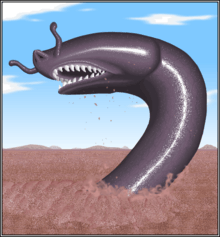Minhocão (animal)
 Artistic depiction of the minhocão. | |
| Grouping | Cryptid |
|---|---|
| First reported | Native Lore |
| Last reported | 2013 |
| Country | South and Central America |
| Region | Forests |
The minhocão ("big earthworm" in Brazilian Portuguese) is a large earthworm or serpent-like cryptid that allegedly exists in the forests of South and Central America.
Appearance
The Minhocão is said to resemble a 20 to 50 meter worm or serpent, with scaly black skin covering its entire body. It is reported to be ectothermic and have highly mobile jaws and is thought to be a burrowing animal, dwelling in enormous trenches or caves beneath the jungle floor.
Identity
Cryptozoologist Karl Shuker has suggested that this animal may be an example of a giant caecilian,[1] which fits the description of the minhocão well. However, known caecilians do not even begin to approach the supposed size of this animal. Superficially similar to the caecilians are the Amphisbaenia or worm lizards, which are distributed throughout much of South America, although most known species are less than 150 mm in length. In On the Track of Unknown Animals, Bernard Heuvelmans suggests that the animal may be a surviving glyptodont. Others have suggested the giant serpent may actually be a descendent of the Titanoboa, a titanic-sized snake that once roamed the same region during the prehistoric era, specifically the Paleocene Epoch.
Habitat
The Minhocão reportedly resides in the wettest and warmest areas of South and Central America, and is a feared part of the culture in that region. The ancient Mayans depicted, through cave carvings and paintings, an extremely large serpent who was believed to eat humans. Some believe these drawings to be of the Minhocão. The possibility that the Minhocão still exists deep in the unexplored forests of South and Central America is debated, though there have been rumored sightings of the ancient serpent as recent as 2013. The Minhocão burrows massive trenches in which it will hide or live in.
See also
References
- ↑ Shuker, Karl (1995). In Search of Prehistoric Survivors. Blandford.
- J. Judson Wynne and William Pleytez, "Sensitive ecological areas and species inventory of Actun Chapat Cave, Vaca Plateau, Belize". Journal of Cave and Karst Studies, 67, no. 3, p. 148–157.